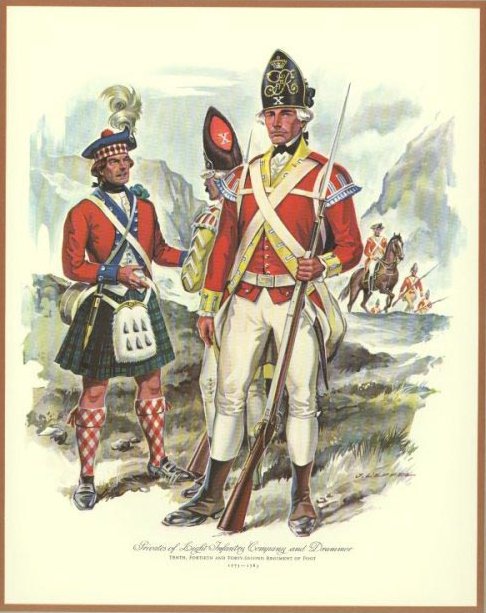![[Ealge with Flag]](eagle1.gif)
| UNIFORMS
OF
THE AMERICAN REVOLUTION The British Tenth Foot was raised by John, Earl of Bath, in 1685 under a royal warrant issued by King James II. Their early uniform was a blue coat lined with red, with red waistcoat, breeches and stockings. Shortly after 1688 the regiment adopted red for the color of their coats. The regiment was stationed in Ireland during the Seven Years War, but with steady growth of the desire for independence in America, they were sent to Boston in 1768. In April of 1775 General Gage sent a force under the command of Lieutenant-Colonel Francis Smith of the Tenth Regiment to Concord to destroy military supplies being stored there by the Americans. The Light Company of the Tenth, shown in our illustration wearing the leather cap, formed part of this force and took part in the actions at Lexington and Concord, as well as in the retreat to Boston. Their next action was at Bunker Hill where their flank companies lost seven killed and forty-six wounded including all of the officers. The Tenth next saw action at Long Island and at White Plains. They occupied Rhode Island in December of 1776 under Clinton. In 1777 they served in Howe's army at Brandywine and helped to occupy Philadelphia. They were engaged at Monmouth in the withdrawal across New Jersey. Because the regiment had been greatly reduced in numbers it was sent home to England in October of 1778, thus ending its service in the American Revolution. The drummer in his yellow coat faced with red clearly shows the practice of dressing the drummers and musicians in reversed-colored clothing. The 42nd Foot was raised in 1739 from the existing independent Companies and called the Highland Regiment of Foot. The regiment served in America during the French and Indian War and was conspicuous for their bravery in the attack on the French abattis at Fort Ticonderoga. By warrant of July 22, 1758 they were given the title "The Royal Highland Regiment of Foot". The 42nd saw action at Long Island, White Plains, Brandywine, Paoli, Monmouth, and later in Virginia. The dress shown in our plate of the highlander in his kilt represents the dress of the Black Watch, or 42nd, in the early years of the war. However, as the war progressed and supplies became harder to get the 42nd adopted the dress of the light troops but still retained their bonnets. [REFERENCES: Historical Record of the Tenth, or the North Lincolnshire Regiment of Foot, Richard Cannon. 1847. A History of the Uniforms of the British Army. Vol. H. H. C. C. P. Lawson.] |
| Privates
of the Light Infantry Company and Drummer
Tenth, Fortieth and Forty-Second British Regiments of Foot 1775 - 1783
|
|
More Uniforms of the American Revolution | Next Page | Uniforms Index | Return to Main Menu eMail the WebmasterCopyright
Notice
|
